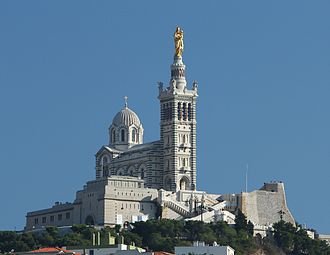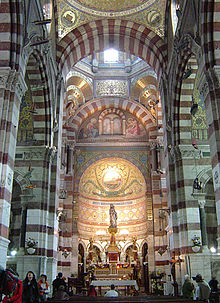Notre-Dame de la Garde
Notre-Dame de la Garde , popularly La Bonne Mère - "good mother" is a Marien - Sanctuary in Marseille . It is visited by two million people every year. The neo-Romanesque - Byzantine church stands on a 161 m high hill and is a landmark of the city that can be seen from afar . The church was at the site of a medieval chapel from 1853, designed by Henri-Jacques Espérandieu built and on 4 June 1864 by the Cardinal Clément Villecourt ordained . In 1879 it received the rank of minor basilica .
history
Pilgrimage chapel
On the triangular rock plateau of the hill La Garde , which later gave the church its nickname, a Marseilles priest Pierre had a small Chapel of the Virgin built in 1214. Even after an expansion of 1477, it held no more than 60 people. From 1524, Francis I had the La Garde hill expanded into a military fortification at the same time as the island fortress Château d'If . The Lady Chapel, now within the fortifications, remained accessible to civilian visitors via a drawbridge . The number of pilgrims grew steadily; From around 1600 Notre-Dame de la Garde was also the Church of Appeal and Thanksgiving for sailors. The chapel was rebuilt for the first time in 1987 and the second time in 1993. This enlarged the front part of the chapel.
Revolution and Restoration
During the French Revolution , the church lost its medieval image , all furnishings and bells. In 1807 it was reopened for worship and gradually restored. In 1837 Jean-Baptiste Chanuel created a new, large silver statue of Our Lady with the child, which today stands in the new basilica above the main altar. In 1845 the small mountain chapel received a huge bell, the Marie-Joséphine , weighing 8,234 kg, for which a separate bell tower was built. Finally, in 1851, the rector of Notre-Dame applied to the War Ministry in Paris to be allowed to build a larger new building with a high tower instead of the old church within the military installation. Approval was granted, and after the decision had been made in favor of the 23-year-old Protestant architect Espérandieu and his Romano-Byzantine design - the competing design called for neo-Gothic forms - the foundation stone was laid on September 11, 1853 by Bishop Eugène de Mazenod .
basilica
The construction of the new church had to be interrupted several times due to lack of money. In 1861 the crypt carved into the rock was completed. At the solemn consecration of the upper church, which Cardinal Villecourt carried out in June 1864 in the presence of 41 bishops, the bell tower was still unfinished. It was not until 1866 that the large Marie-Joséphine bell found its place there. This was followed by the production and installation of the 11.20 m high statue of the Virgin Mary on the top of the tower, a design by Eugène-Louis Lequesne , executed by the Christofle company as a fire-gilded electroplating . It was completed in 1870. The elaborate interior design, especially the large-scale mosaics, took further decades. On April 26, 1886, Cardinal Charles Martial Lavigerie consecrated the main altar. The year 1897, with the installation of the heavy bronze portals, marked the completion of the Notre-Dame de la Garde basilica.
1889-1892 the engineer Emile Maslin built a water ballast- operated funicular from the city to the La Garde hill on a private initiative . It was in operation until 1967; In 1974 it was dismantled.
During the First World War it became clear that the bastions of La Garde no longer had any military value. After many years of negotiations with the War Ministry, the Archdiocese of Marseille was able to buy the entire facility and convert it for its own purposes.
In June 1931, for the 1500th anniversary of the Council of Ephesus with the Theotokos Proclamation, the silver statue of the Virgin Mary was made by Chanuel on behalf of Pope Pius XI. crowned by Cardinal Louis Maurin in the presence of 49 bishops and 300,000 believers .
During the Second World War , German troops holed up on La Garde. During the battles for liberation in August 1944, the basilica received several shell hits, some of which are still visible.
Building description
architecture
The basilica faces southeast . In the north-west, above the double staircase that leads down to the city, is the square, statue-crowned bell tower with the main portal.
The size of the church is relatively modest. The outer length is 52.50 m, the outer width only 16.80 m. The tower is 41 m high up to the angel gallery . With the figure of Mary and the lantern that it carries, it reaches a height of 65 m.
The basilica is a pillared church on a rectangular floor plan. The main nave comprises three bays , which are flanked by chapels instead of side aisles and vaulted with flat domes hidden under the gable roof . The main dome, visible from the outside, on an octagonal tambour, stands above an only hinted crossing , to which the apse is directly connected. The masonry consists of layers of contrasting colors on the outside and inside, which contribute significantly to the oriental character of the building.
Furnishing
Inside, the rich figural and ornamental mosaic decorations on a gold background, which are based on models from Ravenna and Rome, are particularly impressive . It covers the entire apse, the crossing and nave domes and the side chapels. In the upper church and in the crypt there are a total of five statues of the Virgin Mary from different eras and materials, as well as other statues of saints that were created by Joseph Marius Ramus . The furnishings also include the numerous votive offerings that tell of answers to prayer.
Organs
The church has three organs . The main organ was built in 1927 by the organ builders Michel-Merklin & Kuhn. The instrument has 27 registers on two manuals and a pedal .
|
|
|
||||||||||||||||||||||||||||||||||||||||||||||||||||||||||||||||||||||||||||||||||||||||||||||||||||||||||||||||||||||||||||||||
- Coupling: II / I, I / P, II / P
City panorama
From the terrace the visitor has an impressive view over the city with the old port ( Vieux-Port ) and the cathedral of Marseille and on the Mediterranean Sea with the Frioul Islands Ratonneau , Pomègues and the Château d'If .
Individual evidence
- ↑ a b L'édifice en chiffres
- ↑ Une petite chapelle sur une colline
- ↑ a b Au XVIe siècle, la chapelle est englobée dans un fort
- ↑ a b c d e La construction d'un nouveau sanctuaire
- ↑ 1941: l'évêché de Marseille devient propriétaire du haut de la colline
- ^ Haut lieu artistique
- ↑ Information on the organ under the heading Marseille
Web links
- Online presence of the basilica (French, English, Italian)
- Pictures of the church
Coordinates: 43 ° 17 ′ 2 " N , 5 ° 22 ′ 16.7" E



